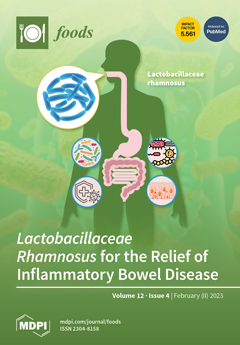Pandanus amaryllifolius Roxb. is a special tropical spice crop resource with broad development prospects. It is widely cultivated under a
Hevea brasiliensis (Willd. ex A. Juss.) Muell. Arg. canopy to improve the comprehensive benefits to
Hevea brasiliensis plantations in Hainan Provence, China. However,
[...] Read more.
Pandanus amaryllifolius Roxb. is a special tropical spice crop resource with broad development prospects. It is widely cultivated under a
Hevea brasiliensis (Willd. ex A. Juss.) Muell. Arg. canopy to improve the comprehensive benefits to
Hevea brasiliensis plantations in Hainan Provence, China. However, the effects of intercropping with
Hevea brasiliensis on the component number and relative contents of volatile substances in different categories in the
Pandanus amaryllifolius leaves are still unknown. Therefore, a
Hevea brasiliensis and
Pandanus amaryllifolius intercropping experiment was set up to clarify the differences between several cultivated patterns on volatile substances in the
Pandanus amaryllifolius leaves, and the key regulatory factors of volatile substances. The results showed that the soil pH was significantly decreased, while soil bulk density, alkali-hydrolyzable nitrogen and available phosphorus contents were significantly increased under the intercropping pattern. The component numbers of esters in volatile substances were increased by 6.20%, while the component numbers of ketones were decreased by 4.26% under the intercropping pattern. Compared with the
Pandanus amaryllifolius monoculture, the relative contents of pyrroles, esters and furanones were significantly increased by 8.83%, 2.30% and 8.27%, respectively, while the relative contents of ketones, furans and hydrocarbons were decreased by 1.01%, 10.55% and 9.16% under the intercropping pattern, respectively. The relative contents of pyrroles, esters, furanones, ketones, furans and hydrocarbons were associated with changes in soil pH, soil available phosphorus content and air temperature. The results indicated that the reduction in soil pH and enhancement in soil-available phosphorus may be the main reasons for promoting the relative content of pyrroles and reducing the relative content of hydrocarbons under an intercropping pattern. Overall,
Hevea brasiliensis intercropping with
Pandanus amaryllifolius could not only improve soil properties, but also significantly increase the relative contents of the main volatile substances in
Pandanus amaryllifolius leaves, which could provide a theoretical basis for the application and promotion of high-quality production patterns of
Pandanus amaryllifolius.
Full article






